Text
The Razor, the Spectre, and extras



Razor was left purposefully lacking a theme, though all the cards involve double strike. Each card exists to cause pain to your opponents, with the creature specifically punishing large plays. This is referencing the Razor's spontaneity, and how Cheated's shotgun approach to problem solving only makes her stronger.


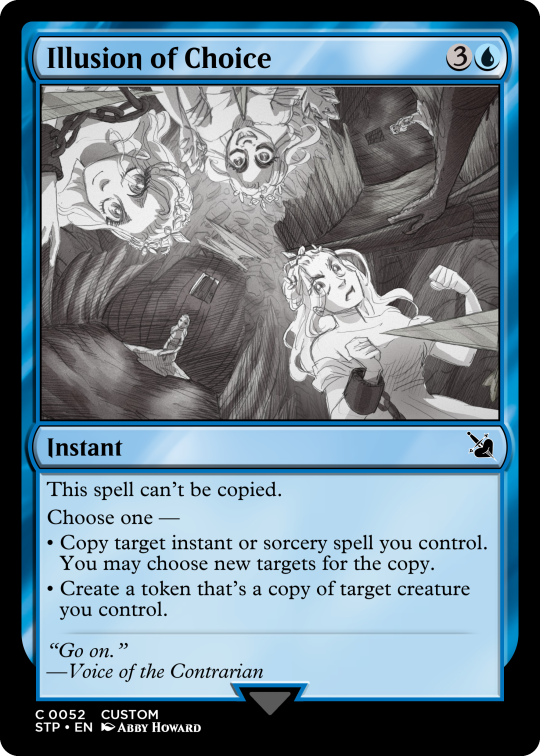
Stranger focuses on copying and face down permanents. The latter interprets unidentified people, the typical flavor for face down permanents, as unidentifiable people. Also, the creature's second ability deserves a bit more explanation. Being face down is not a copyable property, so a token copy of a face down permanent will be a colorless 2/2 creature (with ward {2} if cloaked or disguised) that is face up. This means you cannot pay a mana cost to flip the token, and, importantly, the ability does not go infinite with itself.
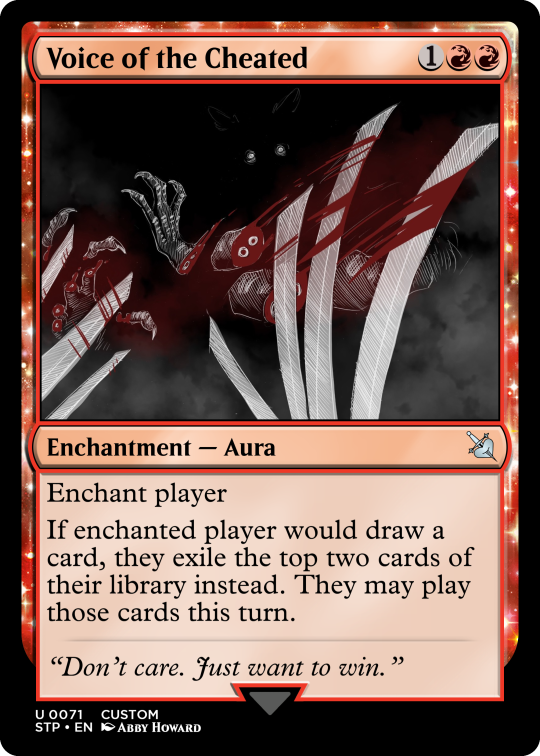

Voice of the Cheated benefits from storm and prowess decks. Given that you're playing spells the turn you draw them anyways, it effectively doubles your draws. It also synergizes well with Razor, which is a massive flavor win. Contrarian benefits from bounce decks, or more broadly decks that benefit from ETBs. If you have the mana to spare, it lets you retrigger an ETB every turn.

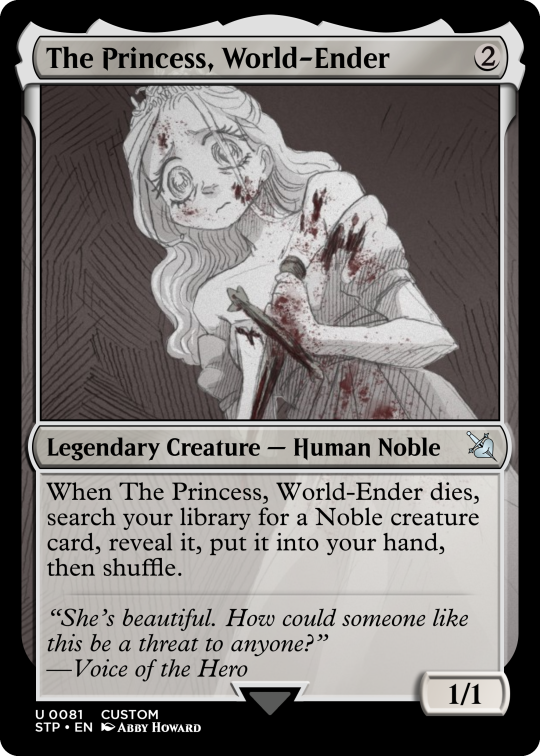
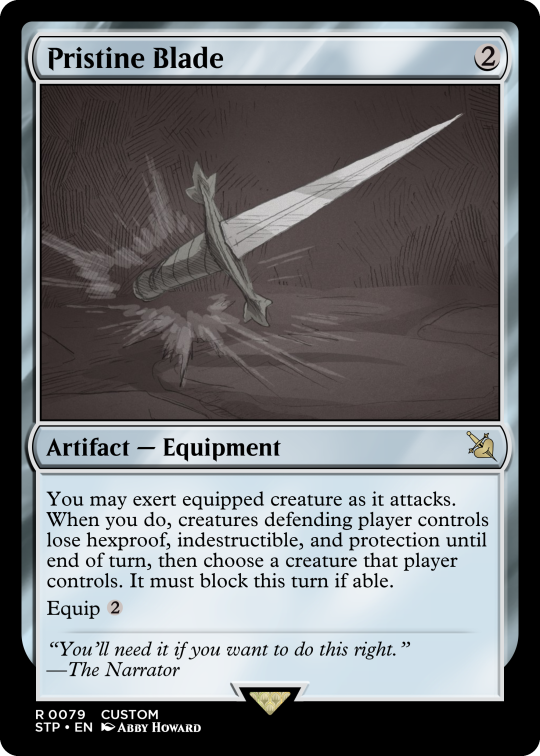
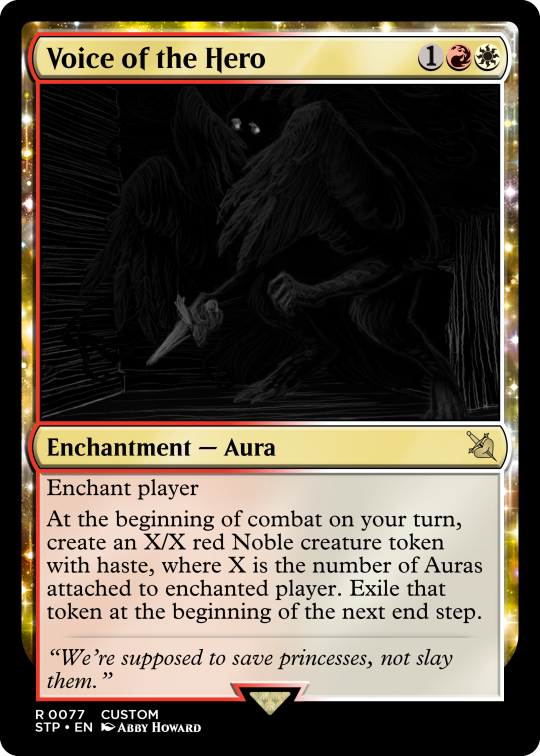

The chapter 1 Princess was made simple and broadly synergistic with Nobles such that it could be run in any deck that cares about any other Princess. The Pristine Blade is similar to Shadowspear, in that it removes different forms of protection from creatures. I tied this ability to exertion to represent how in most cases TLQ is able to kill the Princess when focused and with blade in hand. Similar to the chapter 1 Princess being Noble tribal, Hero is voice tribal. Like the voices, he benefits from being placed on yourself if you are playing voices as boons, and benefits from being placed on an opponent if you are playing voices as curses. The Narrator was not made an Aura because he is always said to be separate from the voices. His ability effectively resets a player if the game is about to end, representing his creation of the construct before the events of the game.
MtG Slay the Princess
[CW: blood & gore]
One thing I have not yet shared on this blog is my love of Slay the Princess (see my pfp). It's a phenomenal game and I'm trying to keep too fast of a pace right now to do it justice. Another thing I've yet to share is my hobby in creating custom Magic: the Gathering cards. Unfortunately, I'm an unimaginative prick who likes to profit off of other's works, so it ends up just being Universes Beyond stuff.
To that end, I now have 80ish cards about this game. That's way too many to talk about in a single post, so I'm splitting it up by related chapters. You can find all the card images, CardConjurer saves, and Cockatrice set file here. With all that said:
The Adversary and the Tower
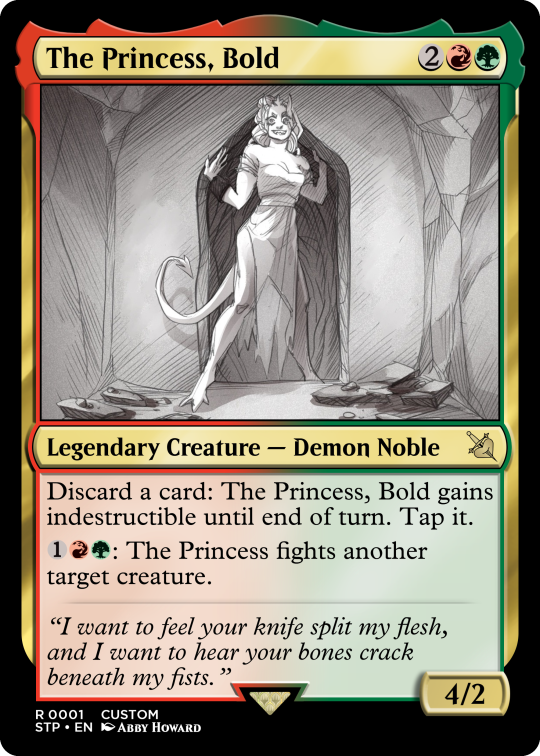
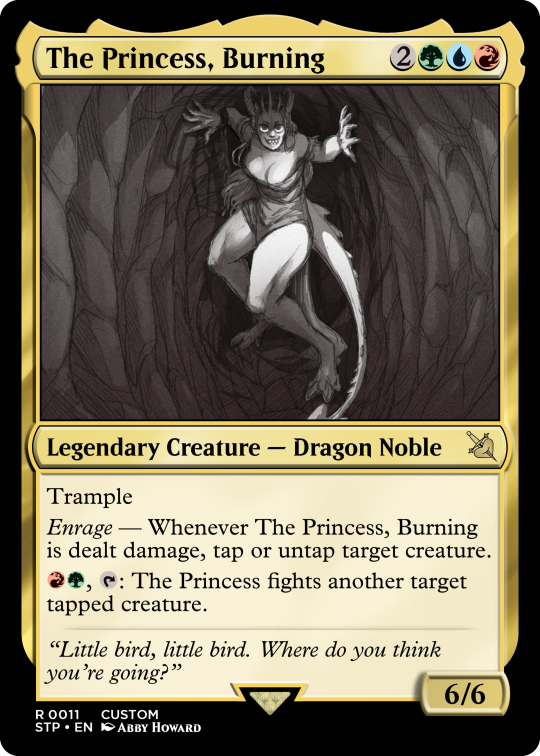



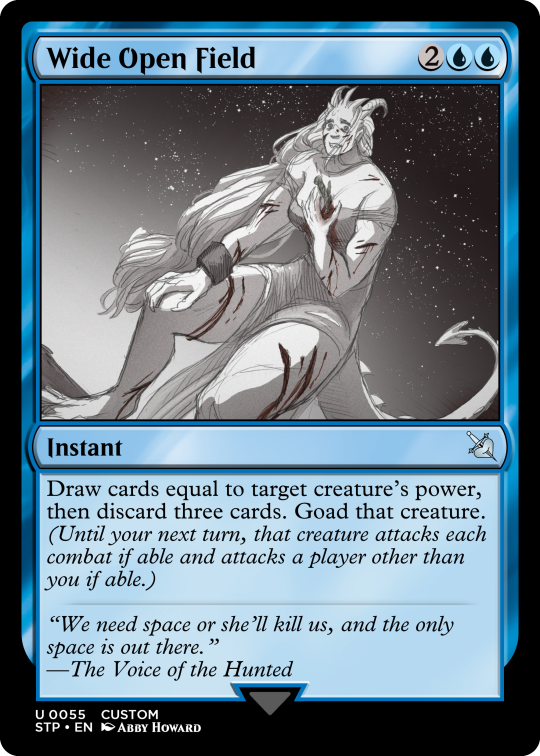
The overall theme with Adversary and EotN was fighting and fighting good. Both creatures can fight repeatedly, though EotN works in tapping as a form of stamina. One theme with all the Sagas is a shared first chapter ability between related two- and three-chapter routes. Each chapter ability on the Saga represents what the player has to do to progress to the next chapter in game, which for these chapters means yet more fighting. Another theme you'll notice in all my cards is inherent trade-offs, such as in Adversary's instant. That's just because I find those designs interesting. The problem is that each spell already has inherent trade-offs in the form of card advantage and a mana cost, so introducing more makes the cards hard to play. I've tried to avoid doing it excessively, but you'll see it pop up semi-regularly.
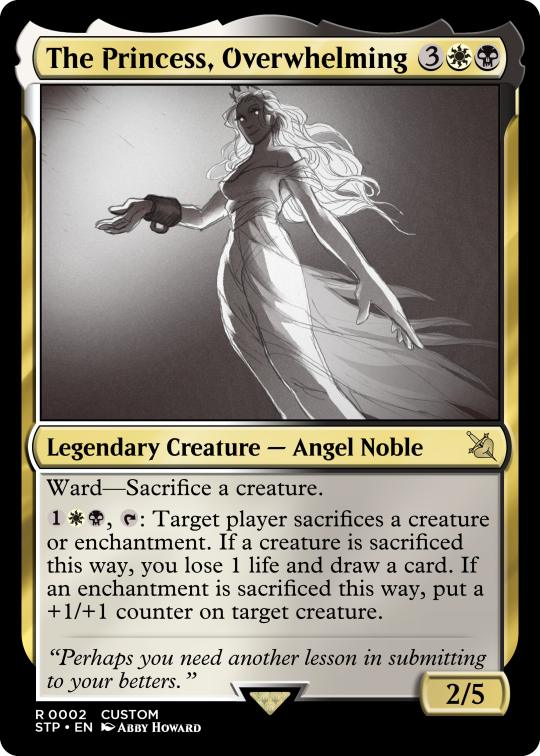





The overall theme with Tower and Apotheosis was tributes. Tower's creature demands sacrifices of other players, and Apotheosis' creature will wipe your opponent's boards with enough exiled cards. Apotheosis getting weaker with each tribute is a bit of a stretch flavor-wise. I wanted to reflect the strain from giving her everything, and her sacrificing herself to grant you freedom, but it was mostly added for balance.
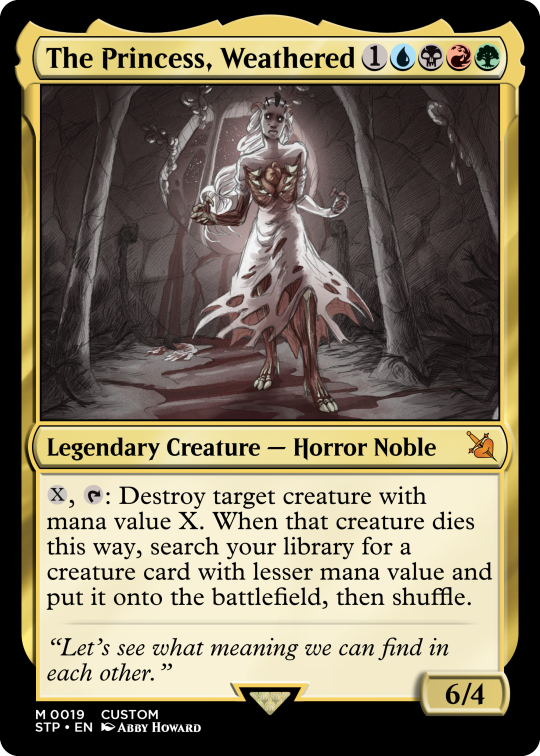


The overall theme with Fury was reusing creatures. My only note about the creature is that there's a reason four-color design is so rare, and I learned that the hard way. The identity can only really be defined by what they lack, and designing "an unwhite card" is really tricky. The Saga has a bit of flavor dissonance in the final chapter ability. In official Magic, devour is styled as consuming another creature, and if I had made Beast or Den full Jund I probably would have used it there. Here I'm using it to represent being woven together, combining the strength of two creatures into one.
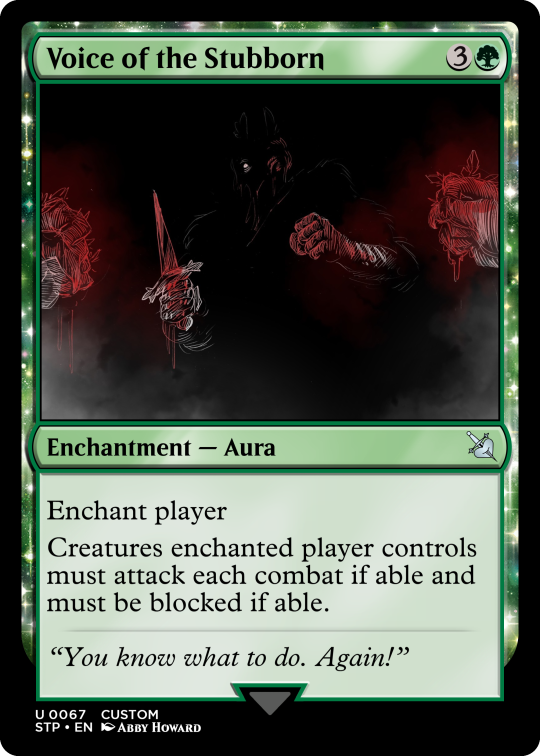
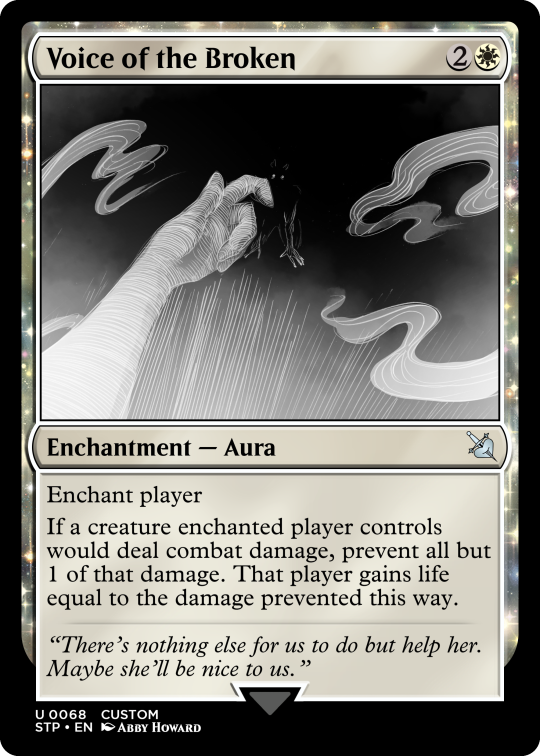
The voices are some of my favorite cards I've ever designed. They are a curse when put on most opponents, but can also be a boon when put on yourself if you've built around them. Stubborn benefits from aggressive, death-based strategies, decks that want to kill other's creatures or their own, and will be swinging out each turn anyways. Broken's downside can be mitigated by go-wide or burn decks, but it really helps lifegain decks, and can give more survivability when going to alternate wincons.
20 notes
·
View notes
Text
The Prisoner and the Damsel
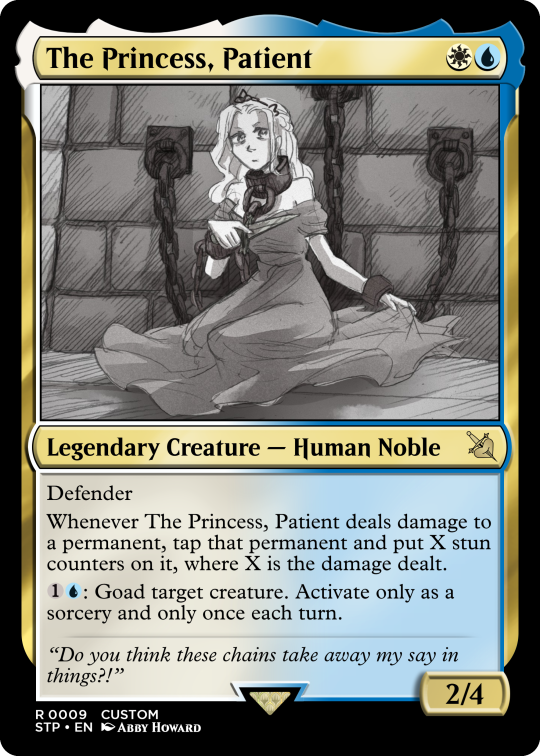

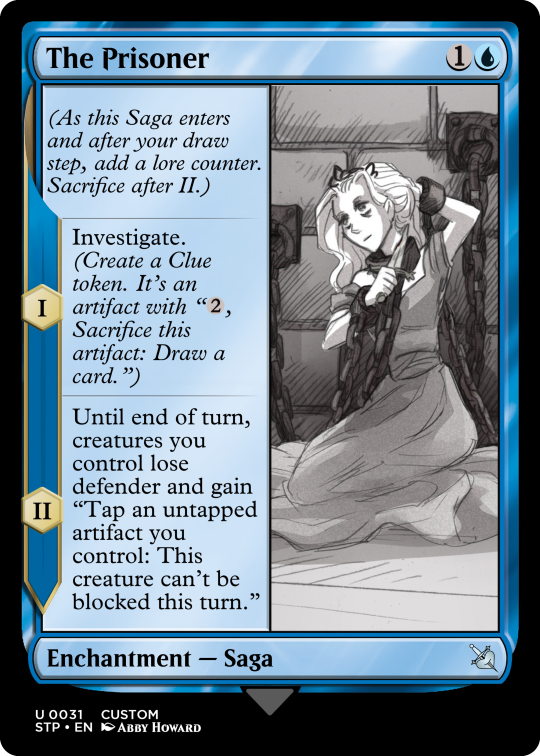
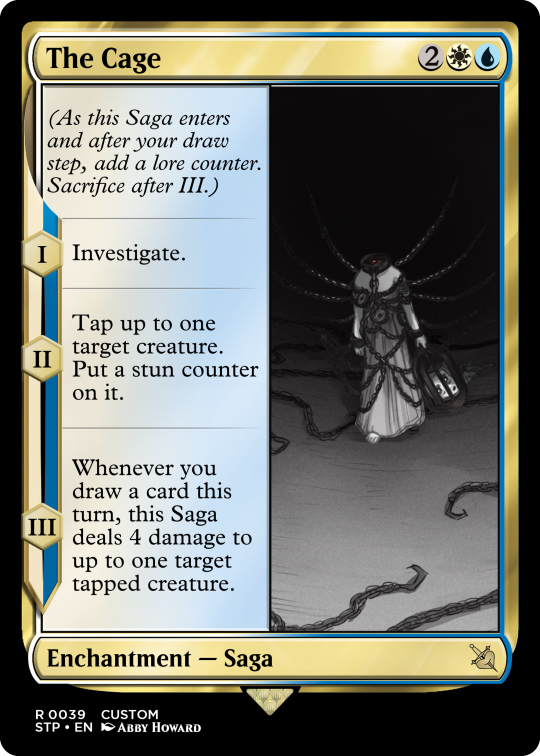

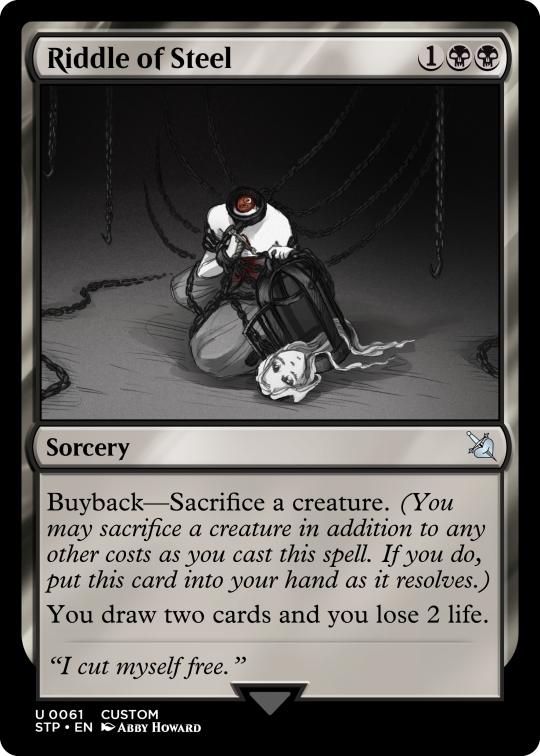
Prisoner and Cage both focus on prison (go figure). Prisoner's creature was a hard design since she needed defender flavorfully, which is an incredibly restrictive ability. I opted to make a bad, flavorful card, though it does have good synergies with fighting or burn. Cage has a minor theme of tokens, representing the mindless bodies that can participate in the dance of battle. Some of Prisoner's card also involve tokens, but focus on Clues as opposed to creatures.
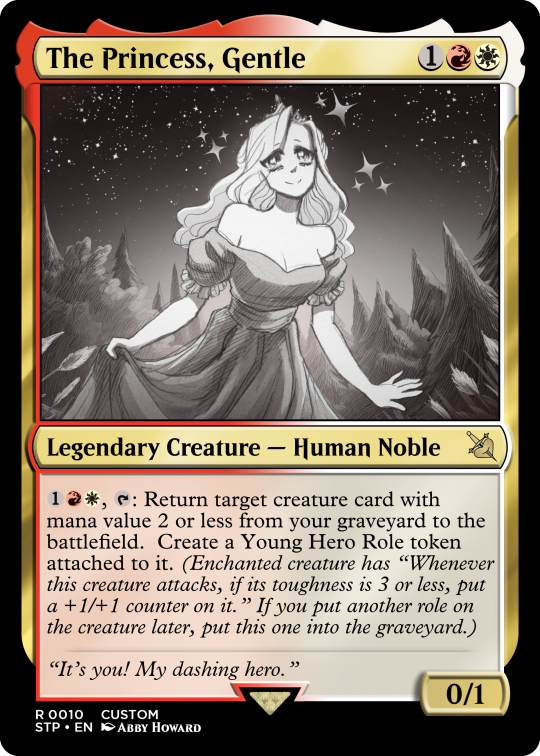




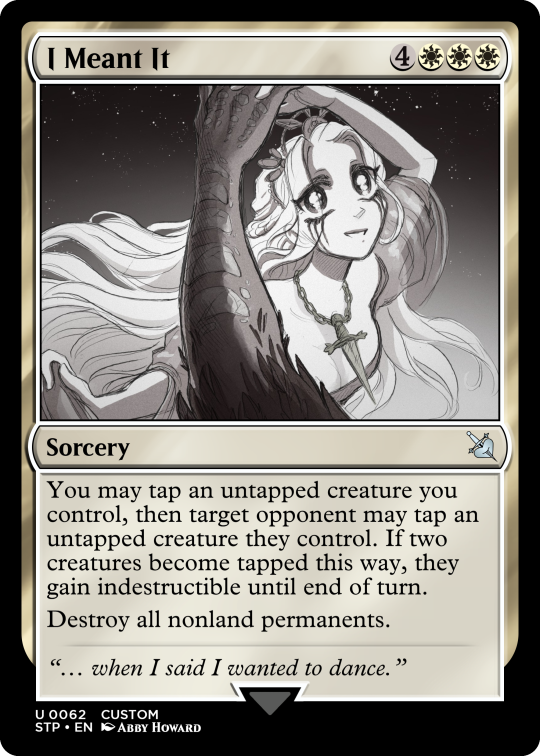
Similar to Cage, Damsel and HEA focus on tokens. Both of the creatures use mechanics from Eldraine, partly because of a shared fairy tale theme but mostly because I like Eldraine and am always looking for ways to use celebration. Damsel uses roles to represent the rigid and simplistic worldview that leads to the chapter. You are the knight in shining armor, and she is the damsel in distress. HEA uses artifact tokens as the games and food she presents you, and sacrifices them to represent throwing it all away for true happiness. As an aside, I originally only wanted to make legendary creatures for each chapter, but had the idea for I Meant It soon after. This single card is the reason why 22 turned into 80.
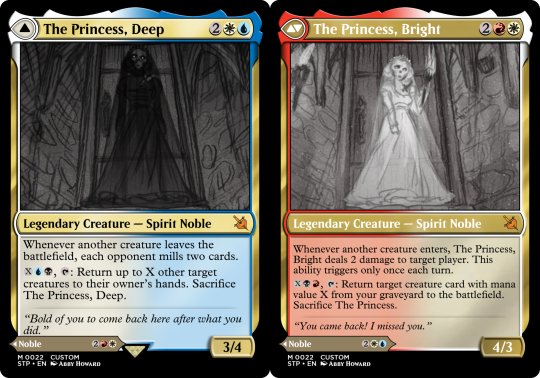
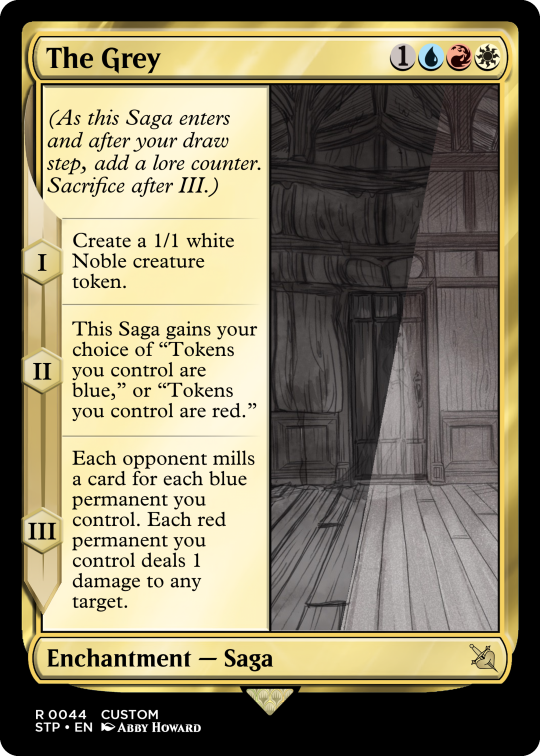
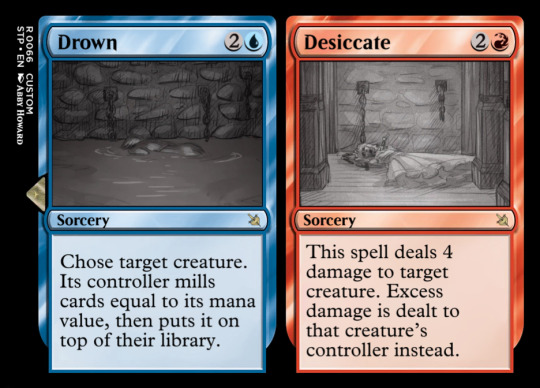
I took a lot of time just deciding how I wanted to rectify Drowned and Burned Grey's unique relationship. While technically the same chapter, the two routes are completely different depending on the proceeding chapters. They act more as independent third chapters like Cage and HEA, thematic similarities notwithstanding. I considered making them entirely separate, but that opened the door to splitting the Prisoner and the Prisoner's head, the Damsel and the Deconstructed Damsel, and the Networked and Wounded Wild. In the end I decided to make each card have some sort of split decision, resulting in different behaviors with some superficial similarity to the other mode.


Skeptic benefits from artifact decks, especially ETB and improvise strategies, as it gives much more support for investigation. The wording also elegantly avoids replacing the first draw of your draw step, which I am quite proud of. Smitten is good in enrage decks. Ironically, this means it synergizes best with EotN, a chapter Smitten does not appear in. I chock this up to classic Magic jank which should not be stifled, so I decided not to actively avoid that while designing.
MtG Slay the Princess
[CW: blood & gore]
One thing I have not yet shared on this blog is my love of Slay the Princess (see my pfp). It's a phenomenal game and I'm trying to keep too fast of a pace right now to do it justice. Another thing I've yet to share is my hobby in creating custom Magic: the Gathering cards. Unfortunately, I'm an unimaginative prick who likes to profit off of other's works, so it ends up just being Universes Beyond stuff.
To that end, I now have 80ish cards about this game. That's way too many to talk about in a single post, so I'm splitting it up by related chapters. You can find all the card images, CardConjurer saves, and Cockatrice set file here. With all that said:
The Adversary and the Tower






The overall theme with Adversary and EotN was fighting and fighting good. Both creatures can fight repeatedly, though EotN works in tapping as a form of stamina. One theme with all the Sagas is a shared first chapter ability between related two- and three-chapter routes. Each chapter ability on the Saga represents what the player has to do to progress to the next chapter in game, which for these chapters means yet more fighting. Another theme you'll notice in all my cards is inherent trade-offs, such as in Adversary's instant. That's just because I find those designs interesting. The problem is that each spell already has inherent trade-offs in the form of card advantage and a mana cost, so introducing more makes the cards hard to play. I've tried to avoid doing it excessively, but you'll see it pop up semi-regularly.






The overall theme with Tower and Apotheosis was tributes. Tower's creature demands sacrifices of other players, and Apotheosis' creature will wipe your opponent's boards with enough exiled cards. Apotheosis getting weaker with each tribute is a bit of a stretch flavor-wise. I wanted to reflect the strain from giving her everything, and her sacrificing herself to grant you freedom, but it was mostly added for balance.



The overall theme with Fury was reusing creatures. My only note about the creature is that there's a reason four-color design is so rare, and I learned that the hard way. The identity can only really be defined by what they lack, and designing "an unwhite card" is really tricky. The Saga has a bit of flavor dissonance in the final chapter ability. In official Magic, devour is styled as consuming another creature, and if I had made Beast or Den full Jund I probably would have used it there. Here I'm using it to represent being woven together, combining the strength of two creatures into one.


The voices are some of my favorite cards I've ever designed. They are a curse when put on most opponents, but can also be a boon when put on yourself if you've built around them. Stubborn benefits from aggressive, death-based strategies, decks that want to kill other's creatures or their own, and will be swinging out each turn anyways. Broken's downside can be mitigated by go-wide or burn decks, but it really helps lifegain decks, and can give more survivability when going to alternate wincons.
20 notes
·
View notes
Text
The Beast and the Witch
Putting my spiel in the preface this time, because I have a lot less to say about these cards. Each group here is a lot less cohesive than the previous posts for various reasons. Witch's creature went through the most revisions of any card in this set by far, so any sort of theme got lost along the way. Wild is a similar story, though it mostly suffered from the fact that I don't like that part of the game that much so I have a hard time thinking critically about it.
That being said, I do think the cards have good flavor individually. Den's creature doesn't have ravenous as the name would imply since I felt that keyword tokens better represented her rapid evolution. Thorn revolves around symmetric effects, resulting in a Jund group hug commander. That has been done before, but I think the card is mechanically interesting nonetheless.











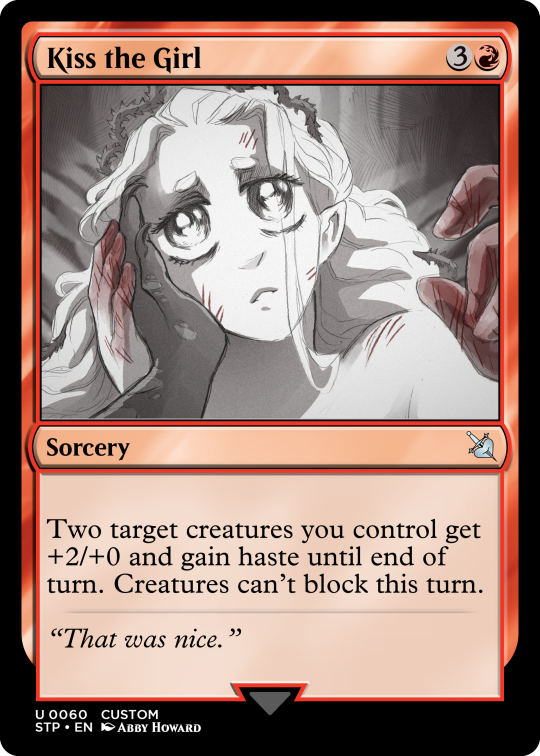

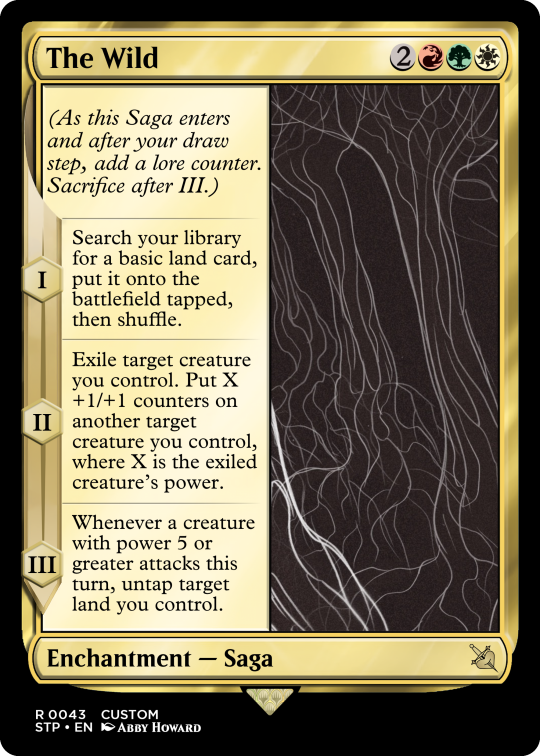



MtG Slay the Princess
[CW: blood & gore]
One thing I have not yet shared on this blog is my love of Slay the Princess (see my pfp). It's a phenomenal game and I'm trying to keep too fast of a pace right now to do it justice. Another thing I've yet to share is my hobby in creating custom Magic: the Gathering cards. Unfortunately, I'm an unimaginative prick who likes to profit off of other's works, so it ends up just being Universes Beyond stuff.
To that end, I now have 80ish cards about this game. That's way too many to talk about in a single post, so I'm splitting it up by related chapters. You can find all the card images, CardConjurer saves, and Cockatrice set file here. With all that said:
The Adversary and the Tower






The overall theme with Adversary and EotN was fighting and fighting good. Both creatures can fight repeatedly, though EotN works in tapping as a form of stamina. One theme with all the Sagas is a shared first chapter ability between related two- and three-chapter routes. Each chapter ability on the Saga represents what the player has to do to progress to the next chapter in game, which for these chapters means yet more fighting. Another theme you'll notice in all my cards is inherent trade-offs, such as in Adversary's instant. That's just because I find those designs interesting. The problem is that each spell already has inherent trade-offs in the form of card advantage and a mana cost, so introducing more makes the cards hard to play. I've tried to avoid doing it excessively, but you'll see it pop up semi-regularly.






The overall theme with Tower and Apotheosis was tributes. Tower's creature demands sacrifices of other players, and Apotheosis' creature will wipe your opponent's boards with enough exiled cards. Apotheosis getting weaker with each tribute is a bit of a stretch flavor-wise. I wanted to reflect the strain from giving her everything, and her sacrificing herself to grant you freedom, but it was mostly added for balance.



The overall theme with Fury was reusing creatures. My only note about the creature is that there's a reason four-color design is so rare, and I learned that the hard way. The identity can only really be defined by what they lack, and designing "an unwhite card" is really tricky. The Saga has a bit of flavor dissonance in the final chapter ability. In official Magic, devour is styled as consuming another creature, and if I had made Beast or Den full Jund I probably would have used it there. Here I'm using it to represent being woven together, combining the strength of two creatures into one.


The voices are some of my favorite cards I've ever designed. They are a curse when put on most opponents, but can also be a boon when put on yourself if you've built around them. Stubborn benefits from aggressive, death-based strategies, decks that want to kill other's creatures or their own, and will be swinging out each turn anyways. Broken's downside can be mitigated by go-wide or burn decks, but it really helps lifegain decks, and can give more survivability when going to alternate wincons.
20 notes
·
View notes
Text
The Spectre and the Nightmare


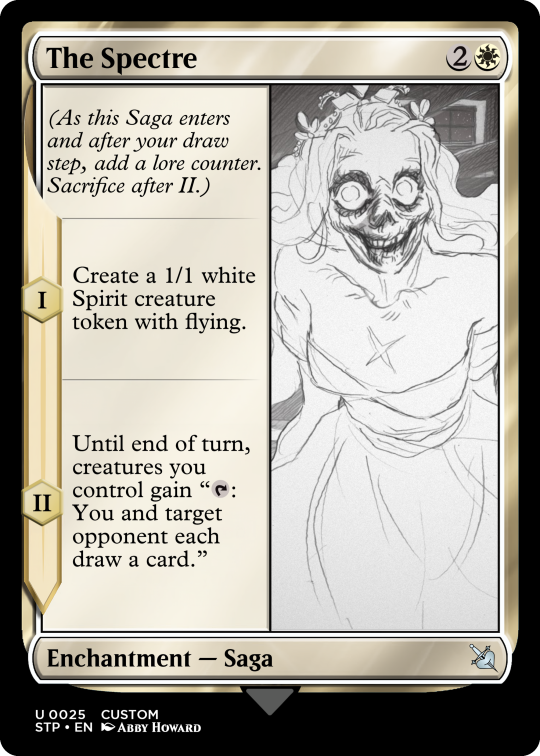



The overall theme with Spectre is cooperation. Spectre herself interprets this and cooperation between players, focusing on mutual card draw. PatD interprets it as cooperation between creatures, adding counters and sharing abilities. As an aside, Sagas have a massive design space in permanents that leave the battlefield after a set amount of time that I feel WotC is just starting to tap into with Final Fantasy's Saga creatures. For PatD's Saga, the second ability reads like banishing but plays like flickering, which plays into the final ability. Also, I won't be posting tokens, but all unique tokens (as in not yet officially printed) can be found here.




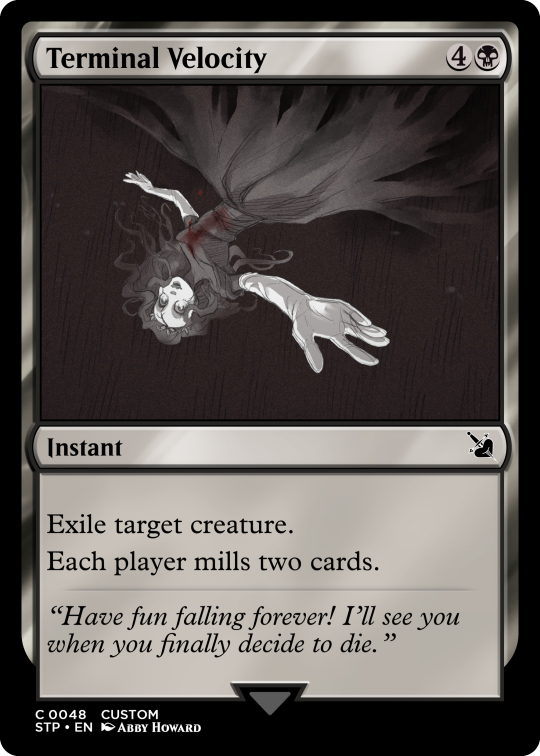

The overall theme with Nightmare is mill, representing insanity. MoC has an additional minor theme in repetition, either through additional combats or graveyard recursion. MoC's Saga is the furthest I dare to push Saga design, and it's second chapter effectively acting as a regular triggered ability makes it play more like a regular enchantment than a Saga. However, the flavor of bringing back horrors to torment your opponents with makes it work in my eyes, if only as a one-off gimmick. I'm also quite proud of Terminal Velocity. Its straightforward, effective, and flavorful. With changed art and flavor text it'd be the only card here that'd feel right as an official card.



The overall theme with Wraith is creature theft. The creature incentivizes creatures to attack their owners, working against their prior goals. This creature was uniquely difficult to determine a color identity for, since red is a common theft color alongside blue and black, but Wraith herself completely disregards your own freedom. I decided to omit red since red's theft are generally presented as a temporary, willful revolt, while blue's and black's are coercion and manipulation.

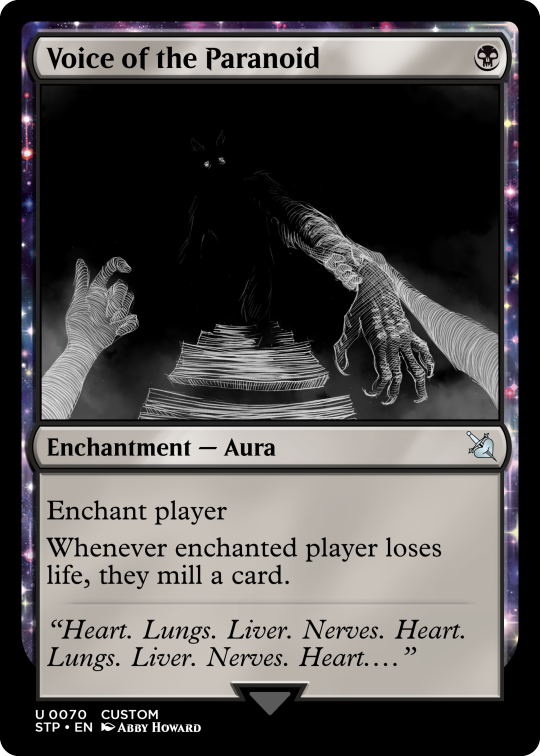
Same as before, the voices are meant to work both as a boon in the right deck and a curse in most others. Cold benefits from a tokens strategy, and to a lesser extent sacrifice decks, though those tend to have heavy recursion which Cold denies. Paranoid works best in a self-mill deck, especially ones making use of black's excessive life payment effects.
MtG Slay the Princess
[CW: blood & gore]
One thing I have not yet shared on this blog is my love of Slay the Princess (see my pfp). It's a phenomenal game and I'm trying to keep too fast of a pace right now to do it justice. Another thing I've yet to share is my hobby in creating custom Magic: the Gathering cards. Unfortunately, I'm an unimaginative prick who likes to profit off of other's works, so it ends up just being Universes Beyond stuff.
To that end, I now have 80ish cards about this game. That's way too many to talk about in a single post, so I'm splitting it up by related chapters. You can find all the card images, CardConjurer saves, and Cockatrice set file here. With all that said:
The Adversary and the Tower






The overall theme with Adversary and EotN was fighting and fighting good. Both creatures can fight repeatedly, though EotN works in tapping as a form of stamina. One theme with all the Sagas is a shared first chapter ability between related two- and three-chapter routes. Each chapter ability on the Saga represents what the player has to do to progress to the next chapter in game, which for these chapters means yet more fighting. Another theme you'll notice in all my cards is inherent trade-offs, such as in Adversary's instant. That's just because I find those designs interesting. The problem is that each spell already has inherent trade-offs in the form of card advantage and a mana cost, so introducing more makes the cards hard to play. I've tried to avoid doing it excessively, but you'll see it pop up semi-regularly.






The overall theme with Tower and Apotheosis was tributes. Tower's creature demands sacrifices of other players, and Apotheosis' creature will wipe your opponent's boards with enough exiled cards. Apotheosis getting weaker with each tribute is a bit of a stretch flavor-wise. I wanted to reflect the strain from giving her everything, and her sacrificing herself to grant you freedom, but it was mostly added for balance.



The overall theme with Fury was reusing creatures. My only note about the creature is that there's a reason four-color design is so rare, and I learned that the hard way. The identity can only really be defined by what they lack, and designing "an unwhite card" is really tricky. The Saga has a bit of flavor dissonance in the final chapter ability. In official Magic, devour is styled as consuming another creature, and if I had made Beast or Den full Jund I probably would have used it there. Here I'm using it to represent being woven together, combining the strength of two creatures into one.


The voices are some of my favorite cards I've ever designed. They are a curse when put on most opponents, but can also be a boon when put on yourself if you've built around them. Stubborn benefits from aggressive, death-based strategies, decks that want to kill other's creatures or their own, and will be swinging out each turn anyways. Broken's downside can be mitigated by go-wide or burn decks, but it really helps lifegain decks, and can give more survivability when going to alternate wincons.
20 notes
·
View notes
Text
MtG Slay the Princess
[CW: blood & gore]
One thing I have not yet shared on this blog is my love of Slay the Princess (see my pfp). It's a phenomenal game and I'm trying to keep too fast of a pace right now to do it justice. Another thing I've yet to share is my hobby in creating custom Magic: the Gathering cards. Unfortunately, I'm an unimaginative prick who likes to profit off of other's works, so it ends up just being Universes Beyond stuff.
To that end, I now have 80ish cards about this game. That's way too many to talk about in a single post, so I'm splitting it up by related chapters. You can find all the card images, CardConjurer saves, and Cockatrice set file here. With all that said:
The Adversary and the Tower






The overall theme with Adversary and EotN was fighting and fighting good. Both creatures can fight repeatedly, though EotN works in tapping as a form of stamina. One theme with all the Sagas is a shared first chapter ability between related two- and three-chapter routes. Each chapter ability on the Saga represents what the player has to do to progress to the next chapter in game, which for these chapters means yet more fighting. Another theme you'll notice in all my cards is inherent trade-offs, such as in Adversary's instant. That's just because I find those designs interesting. The problem is that each spell already has inherent trade-offs in the form of card advantage and a mana cost, so introducing more makes the cards hard to play. I've tried to avoid doing it excessively, but you'll see it pop up semi-regularly.






The overall theme with Tower and Apotheosis was tributes. Tower's creature demands sacrifices of other players, and Apotheosis' creature will wipe your opponent's boards with enough exiled cards. Apotheosis getting weaker with each tribute is a bit of a stretch flavor-wise. I wanted to reflect the strain from giving her everything, and her sacrificing herself to grant you freedom, but it was mostly added for balance.



The overall theme with Fury was reusing creatures. My only note about the creature is that there's a reason four-color design is so rare, and I learned that the hard way. The identity can only really be defined by what they lack, and designing "an unwhite card" is really tricky. The Saga has a bit of flavor dissonance in the final chapter ability. In official Magic, devour is styled as consuming another creature, and if I had made Beast or Den full Jund I probably would have used it there. Here I'm using it to represent being woven together, combining the strength of two creatures into one.


The voices are some of my favorite cards I've ever designed. They are a curse when put on most opponents, but can also be a boon when put on yourself if you've built around them. Stubborn benefits from aggressive, death-based strategies, decks that want to kill other's creatures or their own, and will be swinging out each turn anyways. Broken's downside can be mitigated by go-wide or burn decks, but it really helps lifegain decks, and can give more survivability when going to alternate wincons.
20 notes
·
View notes
Text
I wasn't gonna post anything here but I don't think there's a better place to talk about my most recently played game, Snailshock Grand Supreme Tournament. At its core, it's a game of pool. The balls are snails, however, even the cue ball; and the game plays much more differently than a regular game of pool...
To simplify things, instead of striped and solid-color balls, there are instead preset colors for your and your opponent's snails. Every turn, yours or your opponent's, three dice are rolled. One die has different colored snails, one die has cardinal directions, and one die has the numbers 1-6. You can activate the die before or after your shot, and they will move the snails indicated, in the direction indicated, an amount specified by the 1-6 die. This can either be your snails, your opponent's snails, both, or the cue snail.
The final aspect of the game is the cards. You start with 3, can hold 3 maximum, and you get 1 every time the turn passes to you or you pocket one of your snails. Cards can affect either the snails on the field or the dice.
Onto the score system. Pocketing every snail you have isn't the win condition, it's to defeat your opponent. Pocketing your snails does damage to your opponent, pocketing the opponent's snails or the cue snail does damage to you. If multiple snails of the same color are pocketed during the same turn, they do "combo" damage, potentially winning you the game faster.
Next are the opponents. As of writing, there are a total of sixteen opponents to fight: six regular, six "demonic" (b-side variants), and four tag-team battles, all against a computer opponent. The AI seems fairly rudimentary, which doesn't make the game easier; as each opponent just needs you to run out of HP before they do, relying on their gimmick is usually enough. From my experience, they usually just fire a full-power shot at their closest snail (as evidenced by the times when they repeatedly fired directly into a center pocket to get at a snail on the other side).
The opponents all have their own gimmick. The first enemy, a smiley face, has the gimmick of using some of the same cards you have, once per turn, and the playing field is a bog-standard pool table, lulling you into a false sense of security. The second enemy is a gnome, and his gimmick is dropping exploding "presents" on the now oval-shaped table with pockets at the cardinals. The third opponent is a regal frog who raises and lowers gates that bisect the playing field. This was my first little irritation with the game: you always play first, and the gates that are raised at the start completely prevent you from hitting the cue snail into the other snails. The fourth opponent is a red skeleton with probably the worst gimmick the game has to offer: a lantern that illuminates snails in a small area around it. The rest of the playing field is dark, and while you can see enough to discern the cue snail from the others, the only way to tell what non-illuminated snails are is when you use the dice to move them. It's rather difficult when snails are ricocheting all over the place. The red skeleton will move the lantern every turn, but not by a noticeable amount, and the area it covers is quite small. The fifth enemy is an alien cat! whoopee! and their gimmick is using a ufo to swap your snails with theirs. The swap usually targets snails close to the pocket. The final opponent in the normal tournament I won't spoil the identity of, because it's probably the best setup and joke the game has to offer, but their gimmick is moving the pockets around the field one at a time.
I'd talk about the other opponents but you probably get the idea. With all that in mind, here's what I really wanted to talk about in this game: it's a really unique blend of luck and skill. I know plenty of games claim to have that, but Snailshock probably has the most even split I've seen. You have control over how the three parts interact - snails to cards, cards to dice, and dice to snails - but you have no control over each individual element for the most part.
The cards you get are random, and you have no influence on what you get. You'll quickly realize that you want to burn your cards as soon as possible, because if you pocket two snails between the start of one turn and the next, that's three cards total, and you can't get more if your hand is full. I usually dumped cards as soon as I got them, even if they didn't help. You can still use cards to influence the dice after you use the dice, which has no effect, since they don't stay that way for your opponent. You could use a specific card to lock a die in place, but the only viable option for that is to lock the Snail die to the face of your color. There are plenty of cards that just make it harder for your opponent to score, too - a balloon that prevents snails from falling, or a dreamcatcher to make them stop moving, or a giant hand that ghostifies them and removes all their collision. All these effects last a few rounds, and I haven't found even one to be worth putting on my own snails or the cue snail (although those are both options). After you shoot, the dice proc automatically, and you don't get a chance to play cards, so there's that much less agency.
The dice are random and difficult to influence properly with the cards you're dealt. Sure, you could hold on to a card that changes them, but why bother if it's taking up one of your three precious card slots?
Finally, the positions of the snails may as well be random. Your opponent is taking wild shots (always full power, always at a nearby snail, usually sending stuff out of position), and where the cue snail ends up is unpredictable. Maybe this affects real games of pool as well - I wouldn't know - but between all the effects, getting multiple snails pocketed in one turn is no small feat.
And that brings me to the final aspect - scoring. You earn points for combos, then lose points for fouls (not hitting your snails first with a shot or pocketing the cue snail), then gain points based on your remining HP, plus a flat 50 for winning. To get three stars in a level, you need to score a total of 150 points, which means that (combo points - fouls) + remaining hp % must be greater than 100 to win. It's tricky, but doable, and usually falls to good rolls that get a 3+ combo, combined with your own hp not falling too low.
The vibes are great, though. great jazzy music, great artwork, and it's evident a lot of love was put into it.

(credit: oroshibu)
3 notes
·
View notes
Text

I'm pretty sure this was said in jest but it ties in to another point I want to make. You can win a lot of fights pretty easily with the right build. Critical Mass, Pre-emptive Strike, Resonance, any of these can carry you all the way through the main and post-game story quests. And that's a really good thing! You have to deeply understand the game's mechanics to put any one of these builds together, and the game rewards you heavily for that understanding.
The thing is, this is strategy. You have to think logically about the consequences of including or excluding stickers and how you order them, and what the most consistent and efficient build is for winning. This is what I mean when I say "the weird way I play games". I prefer to think a lot about the prep work so I don't have to think during the execution. There's a weird stigma against this style of play among gamers in general. The prevailing response to me explaining my Resonance build to friends has been along the lines of, "Why do you want to make the game easier?" First of all, why aren't you spending hours putting together a build? That seems like a pretty easy way of playing the game to me. And second, who cares if it's easier? Games are meant to be played by people, so if someone can't play a game 'the right way', because of difficulty or other accessibility concerns, and the developers have provided a way around that, let people take it!
Getting back on topic for a moment, these builds are part of what makes Cassette Beasts a great single player experience, but they are detrimental to the multiplayer. If they were allowed in competitive matches the only viable teams would have turn 0 kills on every tape, and the winner would be decided solely by who had the higher speed. It's fair by the narrowest dictionary definition of the word, but it's certainly not fun. I wouldn't come into the game looking for a competitive experience, since the game wasn't built with it in mind, but if you liked that game and want to try out competitive you won't be left out to dry. There are settings for battles that stop each of the above builds from working, and to my understanding there is a small competitive community that applies additional restrictions. It makes the game play a bit more like Pokémon, which for the multiplayer specifically is a good thing. And of course, if you don't like the idea of a build that wins the game on switch-in for single player, you don't have to make one! The game never forces one playstyle down your throat, so you're free to play however you want.
Completed Cassette Beasts last night (not the DLC yet) and I love this game so much I must tell the whole world about it.
First off, the story is perfect for what it's trying to accomplish. It has its occasional serious moments, mostly to build backstory for a character, but it largely stays out of the way of the player. Its reminiscent of Pokémon in this sense, except those moments of character-building don't fall flat. The cast is legitimately charming, making this one of the few games where I'm glad I'm forced to lug an NPC with me everywhere I go. Also it's implied that the world has similar mechanics to Infinity Train, a very good show that everyone reading this should watch in its entirety.
The combat system is much more compelling than Pokémon as well. Doubles is the default format, which on its own introduces loads more strategy. AP as a replacement for PP forces you to actually strategize instead of clicking the biggest move and sweeping the main story. It also cuts down on forced rests, since the only combat resource that carries between battles is health. The fact that everything is a status effect lets you do very interesting things when you stack them, and the fact that all these status effects are listed with a description makes those interesting things actually understandable.
The best mechanic this game introduces, though, is the sticker system. Eight move slots per beast may sound like a lot, but when "moves" can also be passive abilities (and also AP forcing you to have several different strengths of moves) it becomes necessary. Letting you combine passives is interesting enough on its own, but there's several that let you trigger other moves. If the prospect of engine-building in a monster collector doesn't make your mouth water you should probably stop reading my blog.
The game definitely isn't perfect, but my gripes with it are minor and almost certainly a result of the weird way I play games. Overspill damage makes some sense as a way to level-check certain fights, but once you reach the post game it mostly serves to make mass recording tapes even more tedious (also custom starter makes it sooooo easy to ignore level checks even with overspill). Once you hear a partner's voice line while resting you'll never hear it again, even if it's something really generic like how much they like spending time with you. I worked hard to romance my partner, let me hear their voice!
Overall, if you've ever wanted a slightly more mature single-player Pokémon experience (or just wanted a good modern Pokémon game), pick up Cassette Beasts. And pick Candevil. Glory to Miasmodeus.
48 notes
·
View notes
Text
Completed Cassette Beasts last night (not the DLC yet) and I love this game so much I must tell the whole world about it.
First off, the story is perfect for what it's trying to accomplish. It has its occasional serious moments, mostly to build backstory for a character, but it largely stays out of the way of the player. Its reminiscent of Pokémon in this sense, except those moments of character-building don't fall flat. The cast is legitimately charming, making this one of the few games where I'm glad I'm forced to lug an NPC with me everywhere I go. Also it's implied that the world has similar mechanics to Infinity Train, a very good show that everyone reading this should watch in its entirety.
The combat system is much more compelling than Pokémon as well. Doubles is the default format, which on its own introduces loads more strategy. AP as a replacement for PP forces you to actually strategize instead of clicking the biggest move and sweeping the main story. It also cuts down on forced rests, since the only combat resource that carries between battles is health. The fact that everything is a status effect lets you do very interesting things when you stack them, and the fact that all these status effects are listed with a description makes those interesting things actually understandable.
The best mechanic this game introduces, though, is the sticker system. Eight move slots per beast may sound like a lot, but when "moves" can also be passive abilities (and also AP forcing you to have several different strengths of moves) it becomes necessary. Letting you combine passives is interesting enough on its own, but there's several that let you trigger other moves. If the prospect of engine-building in a monster collector doesn't make your mouth water you should probably stop reading my blog.
The game definitely isn't perfect, but my gripes with it are minor and almost certainly a result of the weird way I play games. Overspill damage makes some sense as a way to level-check certain fights, but once you reach the post game it mostly serves to make mass recording tapes even more tedious (also custom starter makes it sooooo easy to ignore level checks even with overspill). Once you hear a partner's voice line while resting you'll never hear it again, even if it's something really generic like how much they like spending time with you. I worked hard to romance my partner, let me hear their voice!
Overall, if you've ever wanted a slightly more mature single-player Pokémon experience (or just wanted a good modern Pokémon game), pick up Cassette Beasts. And pick Candevil. Glory to Miasmodeus.
48 notes
·
View notes
Note
are there any wellstring mechanics you've discovered that you'd like to share?
Wow stranger, how did you know I play wellstring? There's a few, though I hesitate to say I 'discovered' any of them, I just figured them out on my own.
The most notable is the stamp cancel. A well placed bottle cluster will detonate just as the stamp walks over it, killing them instantly. It's surprisingly easy to set up (aim around the center of where the stamp would next hit the ground, it's very generous) and very hard to identify on account of the giant stamp covering their screen. This is one of the reasons I like running gambit on custom well, since you can set it up much closer to a stamp and still get away.
Stamp cancel works because bottles aren't deleted by specials despite acting like bombs, which also applies to strikes and booyah. You won't get consistent kills with it, but if you see someone going to move through strikes, a blind-fired line of bottles can pretty reliably half them.
Bottles also have really weird interactions with objects. Whenever a charged wellstring shot hits an object it deals both direct damage and explosion damage. This means that you can do the wall bomb thing with your main weapon, since the bottles detonate immediately. This also means that if you can land a vertical shot on the back half of a crab it will kill the rider. And of course this is the reason wellstring is so good at getting pop.
1 note
·
View note
Text
This one's about that game mechanic I alluded to that screws over nova. I will not be linking to that post because this is also just generally applicable game knowledge.
To combat excessive spraying, most shooters implement bloom, meaning the range your shots can randomly spread over increases while continuously firing. Splatoon does not have bloom. Instead, shots from continuously firing weapons (shooters, splatlings, and dualies) have a chance to ignore the random spread of the weapon and shoot directly towards the outer reticle. This chance increases with each shot fired up to a certain maximum, decreases over time when not firing, and is immediately set to a high value whenever you jump. I haven't found a common name for this mechanic (or anything discussing it for that matter) so I will henceforth refer to it as shot deviation.
Usually when I explain shot deviation to someone their first thought is that it helps paint support weapons paint better. After all, more scatter means a wider area covered, and that's probably what the developers intended. However, splash has no shot deviation whatsoever as a result of having perfect accuracy, and zap has the lowest increase per shot at 0.5%, yet these two weapons remain incredible painters. The only useful deviant shots for painting are those fired at the very beginning and very end, since any fired while turning your camera will either hit already painted ground or will be painted over again later.
Common values have shot deviation starting at 1%, increasing by 1% every shot to a max of 25%, and being set to 40% while jumping. Nova on the other hand starts at 10% and increases by 5% every shot. For those counting at home, that means after five shots on your five shot weapon you are at maximum deviation, and one fourth of your shots are all but guaranteed to miss.
I ran calculations for each shooter to find their expected shots to kill with shot deviation, assuming each deviant shot would miss and each nondeviant shot would hit, and the effect was negligible for most, only adding about a tenth of a shot on average. The exception is that shot deviation alone makes nova take an entire extra shot to kill on average. People usually point to the five shot kill as to why nova feels bad to play, but this is the real culprit. Not only is nova actually a six shot kill, but that number will never be the same between engagements. Sure, you could get a five shot kill with some luck, but even if you have perfect aim and only take fights when your deviation is at its lowest you are more likely than not to have a kill take eight shots or more over the course of a match. This is especially prudent for a special spam weapon that needs to conserve its meter, since a fight you should easily win on paper can drag on and lead to your death due entirely to chance.
This is rapidly turning into a nova-specific rant, so if you only care about the general mechanic of shot deviation that part is now done. I'm going to talk about what I want out of nova if it somehow doesn't get cut for 4.
Nova's secondary niche outside of special spam is painting while fighting. It paints a massive area just by looking at people, and that makes it hard to approach, letting you take some surprisingly aggressive positions despite the low kill power. To this end high shot deviation actually helps the weapon about as much as it could help anything, since if you're not moving your camera while firing deviant shots will lead to a more even spread.
After the jump buff, though, it seems like the developers are experimenting with making the weapon slipperier. I think this should be pushed along by making the weapon a lightweight, giving it an interesting niche as the longest range lightweight in the game, and by massively reducing the shot deviation. Nova frankly doesn't need it to paint enough to deter approaches, and giving it a more consistent kill time would make taking fights much more viable. Together these would make the weapon more like squelchies (the natural conclusion to all dual squelcher derivatives) in the sense that its an incredibly slippery midrange skirmisher, with the main differences being higher paint and ink efficiency at the cost of lower range and kill power.
4 notes
·
View notes
Text
I haven't seen anyone mention the nova buff, likely because nobody plays this weapon, but I'm nobody so I'm gonna talk about it.
For anyone uninformed, the buff reduced the jumping accuracy penalty by 33%, which looks like this in game.


This is huge for the weapon. Before this patch it wasn't worth running intensify, but now it doesn't need to.
You still take a hit to your effective DPS while jumping because of the 40% shot deviation (I'll rant about that mechanic some other time), but that hit is much smaller now and is finally outweighed by the survivability you get from jumping constantly. It also gives nova a new niche in being the long range shooter that jumps, which ties in well to the existing playstyle of generally being hard to approach and pin down.
I would be remiss to not point out that "long range shooter that jumps" is a very similar niche to squelchies, which is comical considering their shared origin. Also, while I cannot say that skirmisher nova is viable, I can say that 3 subs of intensify gets you pretty dang close to no accuracy penalty.
5 notes
·
View notes
Text
After playing Octobrush for 3,000-odd games I can say this weapon has a lot of problems that all boil down to this image.

For context, Octobrush takes 30 frames to kill on paper, but at this range it usually takes 40. That is, assuming they don't just hold back and fall out of your hitbox.
The reason why this happens is because, despite having one of the widest areas of effect in the game (comparable to Dynamo), all that area is being covered by only three hitboxes. This means that when one connects it leaves a massive gap between the remaining hitboxes, which makes Octobrush unable to ink opponent's feet, a downside that hurts especially bad on the weapon with low range and a 40 frame kill time.
The big hitboxes ruin a lot of other things for this weapon. Projectiles prefer colliding with terrain over players, which means if you're too close to a wall your swings will get eaten. This forces Octobrush to take corners wide and makes it very hard to pressure enemies in corridors or taking peeks (I've been called nuts for insinuating that peeks are a thing in this game. Your bullets come from your gun, which you hold on your right side. If you stand behind the right edge of a wall you can still fire while obscuring your body, making you harder to hit. It's geometry I'm not insane). It also makes Octobrush inconsistent in 2v1s, something it should ostensibly be good at as a an AoE slayer, since if the opponents are standing too close together you'll only ever be able to hit one of them per swing.
I get that Octobrush is meant to be a beginner weapon and isn't supposed to be viable at high level, but so much of what's holding it back feels less like intentional game design and more like a quirk of the physics engine. The fact that backing yourself into a corner gives you a better shot at survival against this weapon than trying to outmaneuver it feels so bad from the Octobrush's point of view. Give it more hitboxes, give it a melee hitbox while swinging, give it burst or dart, heck, bring back the Splatoon 1 tech where you could land multiple hitboxes at once for increased damage (after adjusting the damage of course), anything to give it the consistency that a introductory weapon should have.
It feels kind of weird to rag on a mid-tier for this long. I don't think Octobrush is bad per se, but I think its reputation as a worse Carbon ironically led to people giving it a bit more credit than it's due. It has a lot more problems than just being slower than Carbon. To be clear I do enjoy this weapon in spite of all these flaws. I think out of all the zip weapons in the game vanilla Octobrush has the highest synergy with the special. It's not enough to surpass Stamper simply because Stamper is an incredibly good main, but the fact that you get to choose between landing on people and sitting above them with falloff and both choices are viable is crazy fun. Nouveau is also the only frontline weapon with rain in the game, meaning it's the only weapon that can really fight in its own rain. I will continue to play this weapon for the foreseeable future, if mostly for the fact that after two years of playing this game I still can't aim.
13 notes
·
View notes